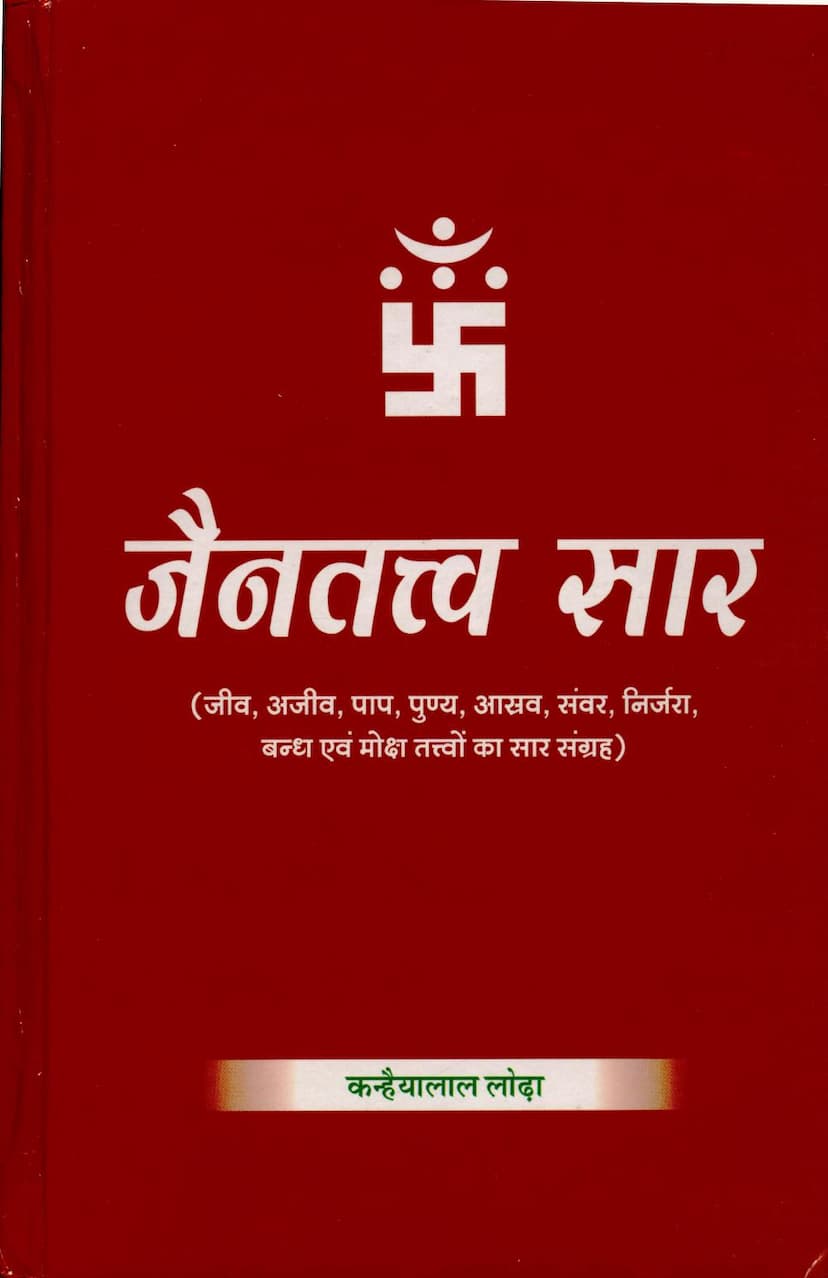Jain Tattva Sara
Added to library: September 2, 2025

Summary
Here's a comprehensive summary of the Jain text "Jain Tattva Sara" by Kanhiyalal Lodha, based on the provided pages:
Book Title: Jain Tattva Sara (Essence of Jain Principles) Author: Kanhiyalal Lodha Publisher: Prakrit Bharati Academy, Jaipur
Core Subject: The book is a concise collection and summary of the nine fundamental tattvas (principles) of Jain philosophy, as presented by Lord Mahavir. It aims to provide readers with a brief yet accessible understanding of these core concepts, which are crucial for the path to liberation (moksha).
Key Tattvas Covered: The book systematically summarizes the nine tattvas:
- Jiva (Soul): The principle of the living being, characterized by consciousness and the capacity for experience.
- Ajiva (Non-Soul): The principle of the non-living matter, lacking consciousness.
- Punya (Merit/Virtue): Actions and intentions that lead to happiness and favorable outcomes.
- Papa (Demerit/Sin): Actions and intentions that lead to suffering and unfavorable outcomes.
- Asrava (Influx of Karma): The process by which karmic particles attach to the soul due to passions and activities.
- Samvara (Cessation of Karma Influx): The process of stopping the influx of new karmas by controlling the senses, passions, and activities.
- Nirjara (Shedding of Karma): The process of eliminating accumulated karmas through austerities and spiritual practices.
- Bandha (Bondage of Karma): The state of the soul being bound by karmic particles.
- Moksha (Liberation): The ultimate goal of Jainism, the state of complete freedom from karmic bondage and suffering, leading to the soul's pure, inherent state of omniscience, bliss, and omnipotence.
Author's Approach and Context:
- Conciseness and Accessibility: The book is intended for readers who wish to understand the essence of the nine tattvas quickly and easily. It serves as a summary of the author's more detailed works on each of these tattvas.
- Spiritual Foundation: The core objective of Jainism, as highlighted in the book, is liberation (moksha) from the cycle of birth and death. Attaining this liberation is achieved through knowledge of these tattvas and practicing the prescribed path.
- Author's Expertise: Kanhiyalal Lodha is presented as a prominent scholar of Jainism, particularly renowned for his expertise in the theory of karma and as a dedicated spiritual practitioner.
- Scientific and Philosophical Integration: The author's approach, as evidenced by references to his other works like "Jiva-Ajiva Tattva in the Light of Science," suggests an effort to present Jain principles in a way that is understandable and resonates with modern scientific perspectives where applicable, while remaining firmly rooted in Jain scriptures (agamas).
- Inspiration: The book was written at the inspiration of Devendra Raj Mehta, the founder and chief patron of Prakrit Bharati Academy.
Key Philosophical Themes:
- The Nature of Reality (Tattvas): The book emphasizes the fundamental Jain understanding of reality as comprising living (Jiva) and non-living (Ajiva) substances. The interaction of these, influenced by actions (karma), leads to bondage and the possibility of liberation.
- The Goal of Life (Moksha): Moksha is presented as freedom from bondage, achieving self-sovereignty, and attaining ultimate happiness.
- The Path to Liberation (Nava Tattva Sadhana): The nine tattvas are not just theoretical concepts but form the framework for the spiritual path. Understanding Asrava, Samvara, Nirjara, and Bandha are crucial steps in the journey towards Moksha.
- The Nature of Truth (Satya): The book delves into the Jain concept of truth as something eternal, unchanging, self-proven, and universal. It contrasts this with transient, conditional states (vibhava) that lead to suffering.
- Self-Realization and Inner Knowledge (Nija Gnana): The text stresses the importance of recognizing and acting upon one's innate, self-evident knowledge, which is often obscured by attachment (raga) to sensory pleasures and the ego (dehabhimana).
- The Role of Vitaragta (Non-attachment): The ultimate state of liberation is described as one of Vitaragta, freedom from attachment and aversion. This state leads to peace, self-sovereignty, and eternal bliss.
- Karma Theory: The book explains that karma is the primary cause of bondage. It touches upon the concept of shedding karma (Nirjara) and accumulating merit (Punya) and demerit (Papa) as part of the karmic cycle. The text emphasizes that the cessation of passions (kashayas) is key to achieving Vitaragta and ultimately Moksha.
- The Importance of Conduct (Charitra): The book underscores that true knowledge (Samyak Gnana) must be followed by right conduct (Samyak Charitra) and right faith (Samyak Darshan) to pave the path to Moksha.
Structure of the Summary Chapters:
The summary is organized by the nine tattvas, with each chapter dedicated to explaining its essence, significance, and relation to the path of liberation. The author's previous works are referenced, indicating that this "Tattva Sara" serves as an accessible overview of his more extensive analyses.
Overall Purpose:
"Jain Tattva Sara" aims to demystify the core principles of Jainism, making them understandable to a broader audience. By presenting the essence of the nine tattvas, the book guides readers towards spiritual understanding and the ultimate goal of liberation, emphasizing self-effort and right conduct as the means to achieve it. The author's commitment to making complex philosophical concepts accessible is a recurring theme.